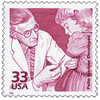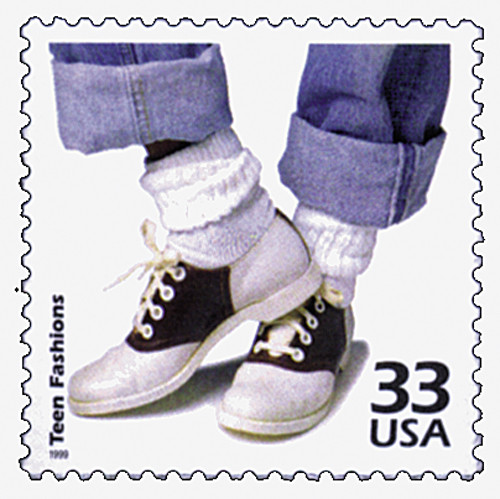
# 3187a - 1999 33c Celebrate the Century - 1950s: Polio Vaccine Developed
US #3187a
1999 Polio Vaccine Developed – Celebrate the Century (1950s)
• Part of the sixth sheet in the Celebrate the Century stamp series issued from 1998-2000
• Commemorates the creation of the polio vaccine
• Includes text on the back with historical details
Stamp Category: Commemorative
Series: Celebrate the Century
Value: 32¢ First Class Mail Rate
First Day of Issue: May 26, 1999
First Day City: Springfield, Massachusetts
Quantity Issued: 188,000,000
Printed by: Ashton Potter (USA) Ltd.
Printing Method: Offset, Intaglio
Format: Panes of 15
Perforations: 11.5
Tagging: Block Tagging
Why the stamp was issued: To honor the countless lives saved and improved by the invention and widespread use of the polio vaccine.
About the stamp design: Pictures a painting by Dean Ellis of a doctor administering the polio vaccine to a little girl. Includes the following text on the back: “Polio epidemics peaked in the ‘50s, with almost 58,000 new cases in 1952 alone. A vaccine developed by Dr. Jonas Salk, and federally approved in April 1955, helped control the spread of the disease when it was administered nationwide.”
First Day City: The First Day of Issue Ceremony was held at the Civic Center in Springfield, Massachusetts, the hometown of Dr. Seuss.
About the Celebrate the Century series: The USPS launched the Celebrate the Century series in 1998 to mark the end of the 20th century and herald the arrival of the 21st. The series includes 10 sheets of 15 stamps (150 in total), with each honoring important moments from a different decade (1900s, 10s, 20s, 30s, 40s, 50s, 60s, 70s, 80s, and 90s). At the time of completion, it was the longest and most ambitious commemorative stamp series in US history.
History the stamp represents: Severe poliomyelitis epidemics have been reported all over the world. In the United States, the number of polio victims was at its highest from 1942 to 1953. During this time, epidemics also occurred in Denmark, Germany, Belgium, and several Asian countries.
In 1947, US physician Jonas Salk began research on the polio virus at the University of Pittsburgh School of Medicine. After discovering there were three strains of the virus, eh worked to develop a vaccine which would kill each one. He conducted his first field tests in 1952, first on children who had recovered from polio, and later on those who had never had the disease. Both tests were successful, and his findings were published the next year in the Journal of the American Medical Association. In 1954, tests were done on an even larger scale. The vaccine, injected with a needle, was found to reduce the incidence of polio. The vaccine was released for use in the US on April 12, 1955.
Dr. Albert Sabin also contributed to the victory over polio. He discovered that live, weakened virus, administered orally, would provide immunity over a longer period of time than killed, injected virus. After extensive research and testing, the oral polio vaccine was approved for use in the US in 1961.
US #3187a
1999 Polio Vaccine Developed – Celebrate the Century (1950s)
• Part of the sixth sheet in the Celebrate the Century stamp series issued from 1998-2000
• Commemorates the creation of the polio vaccine
• Includes text on the back with historical details
Stamp Category: Commemorative
Series: Celebrate the Century
Value: 32¢ First Class Mail Rate
First Day of Issue: May 26, 1999
First Day City: Springfield, Massachusetts
Quantity Issued: 188,000,000
Printed by: Ashton Potter (USA) Ltd.
Printing Method: Offset, Intaglio
Format: Panes of 15
Perforations: 11.5
Tagging: Block Tagging
Why the stamp was issued: To honor the countless lives saved and improved by the invention and widespread use of the polio vaccine.
About the stamp design: Pictures a painting by Dean Ellis of a doctor administering the polio vaccine to a little girl. Includes the following text on the back: “Polio epidemics peaked in the ‘50s, with almost 58,000 new cases in 1952 alone. A vaccine developed by Dr. Jonas Salk, and federally approved in April 1955, helped control the spread of the disease when it was administered nationwide.”
First Day City: The First Day of Issue Ceremony was held at the Civic Center in Springfield, Massachusetts, the hometown of Dr. Seuss.
About the Celebrate the Century series: The USPS launched the Celebrate the Century series in 1998 to mark the end of the 20th century and herald the arrival of the 21st. The series includes 10 sheets of 15 stamps (150 in total), with each honoring important moments from a different decade (1900s, 10s, 20s, 30s, 40s, 50s, 60s, 70s, 80s, and 90s). At the time of completion, it was the longest and most ambitious commemorative stamp series in US history.
History the stamp represents: Severe poliomyelitis epidemics have been reported all over the world. In the United States, the number of polio victims was at its highest from 1942 to 1953. During this time, epidemics also occurred in Denmark, Germany, Belgium, and several Asian countries.
In 1947, US physician Jonas Salk began research on the polio virus at the University of Pittsburgh School of Medicine. After discovering there were three strains of the virus, eh worked to develop a vaccine which would kill each one. He conducted his first field tests in 1952, first on children who had recovered from polio, and later on those who had never had the disease. Both tests were successful, and his findings were published the next year in the Journal of the American Medical Association. In 1954, tests were done on an even larger scale. The vaccine, injected with a needle, was found to reduce the incidence of polio. The vaccine was released for use in the US on April 12, 1955.
Dr. Albert Sabin also contributed to the victory over polio. He discovered that live, weakened virus, administered orally, would provide immunity over a longer period of time than killed, injected virus. After extensive research and testing, the oral polio vaccine was approved for use in the US in 1961.














